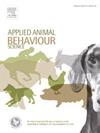Impact of variations in training schedules on dogs’ acquisition and retention of an odor detection task
IF 2.2
2区 农林科学
Q1 AGRICULTURE, DAIRY & ANIMAL SCIENCE
引用次数: 0
Abstract
Detection dogs are typically required to learn a wide variety of target odors which is often time consuming and costly. Therefore, determination of factors that could maximize efficiency of training while maintaining accuracy in performance is crucial. Greater spacing, both within and between training sessions, has been shown to improve task acquisition in dogs and other species, but this variable has not been evaluated during training for an odor detection task. Thus, 48 labrador retrievers from a purpose-bred working dog population were divided into four groups to determine how spacing of training sessions (i.e., concentrated across 5 days or dispersed across 10 days) and the use of intra-session breaks (i.e., break mid-session or entire session completed without a break) would impact acquisition of initial detection training and retention of training after one week. Contrary to previous findings, concentrated training improved acquisition of an odor detection task. Intra-session breaks did not influence task acquisition but did improve retention of learning, although this difference was only observed in dogs that received a concentrated training schedule. However, other factors related to temperament traits appear to be influencing the effects of learning schedules on task acquisition and overall training proficiency in this population of dogs. The findings of this study provide insight into how training schedules may be structured to promote both task acquisition and training efficiency during initial detection training.
求助全文
约1分钟内获得全文
求助全文
来源期刊

Applied Animal Behaviour Science
农林科学-行为科学
CiteScore
4.40
自引率
21.70%
发文量
191
审稿时长
18.1 weeks
期刊介绍:
This journal publishes relevant information on the behaviour of domesticated and utilized animals.
Topics covered include:
-Behaviour of farm, zoo and laboratory animals in relation to animal management and welfare
-Behaviour of companion animals in relation to behavioural problems, for example, in relation to the training of dogs for different purposes, in relation to behavioural problems
-Studies of the behaviour of wild animals when these studies are relevant from an applied perspective, for example in relation to wildlife management, pest management or nature conservation
-Methodological studies within relevant fields
The principal subjects are farm, companion and laboratory animals, including, of course, poultry. The journal also deals with the following animal subjects:
-Those involved in any farming system, e.g. deer, rabbits and fur-bearing animals
-Those in ANY form of confinement, e.g. zoos, safari parks and other forms of display
-Feral animals, and any animal species which impinge on farming operations, e.g. as causes of loss or damage
-Species used for hunting, recreation etc. may also be considered as acceptable subjects in some instances
-Laboratory animals, if the material relates to their behavioural requirements
 求助内容:
求助内容: 应助结果提醒方式:
应助结果提醒方式:


